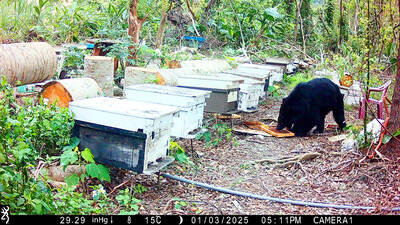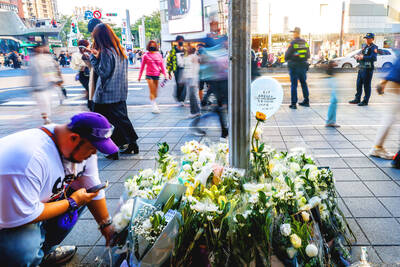Malignant tumors have been the leading cause of death in Taiwan for 38 consecutive years, the Ministry of Health and Welfare said yesterday, in reporting the top 10 causes of death for last year.
Last year, 50,232 people died of cancer, or 28.6 percent of all deaths, Department of Statistics official Chen Ya-li (陳雅俐) said, adding that the annual mortality rate rose 1.8 percent from a year earlier to 212.9 deaths per 100,000 population.
Most people who died from cancer last year were aged 55 or older, or about 85 percent of all cancer deaths, she said, adding that based on mortality rates, the six leading types of cancer deaths, based on mortality rates, was the same as the year before.
The top 10 causes of cancer death are bronchogenic carcinoma and lung cancer, followed by liver cancer and bile duct cancer, colorectal cancer, female breast cancer, oral cancer, prostate cancer, pancreas cancer, gastric cancer, esophageal cancer and ovarian cancer.
Cancer has been the leading cause of death in Taiwan for 38 years, Department of Statistics Director Lee Chiu-yen (李秋嬿) said, adding that last year, one person died of cancer every 10 minutes, 27 seconds — a rate 12 seconds faster than a year earlier.
People should take advantage of government-funded cancer screening services because detecting cancer at an earlier stage leads to earlier treatment and increased survival rates, she added.
Last year, 175,424 people died, 2,565 more than a year earlier, Lee said, adding that 127,461 people, or 72.7 percent of all deaths, were aged 65 or older.
As in the prior four years, the 10 leading causes of death last year were cancer, heart disease, pneumonia, cerebrovascular disease, diabetes, unintentional injuries, chronic lower respiratory disease, hypertension, kidney disease and liver disease, she said.
The top 10 causes accounted for 135,933 of all deaths last year, or about 77.5 percent, Lee said, adding that pneumonia caused 6.9 percent of all deaths, kidney disease caused 4.9 percent and hypertensive heart disease caused 3.1 percent.
However, the leading causes of death differed by age group, she said, adding that the leading cause of death for people aged 25 or younger was unintentional injuries, while the top two causes for people aged 25 to 44 were cancer and suicide.
Last year, 3,864 deaths were by suicide, the 11th overall leading cause, Chen said.
Although deaths by suicide last year only increased by one from a year earlier, deaths by suicide among those aged 15 to 24 rose by 257 deaths, or nearly 30 percent, Chen added.
A case analysis suggested that the increase in suicides among young people is linked to a lack of family support, which makes them feel like they are facing mental stress on their own, Department of Mental and Oral Health Director-General Chen Li-chung (諶立中) said.
Most suicidal behavior among young people is “impulsive,” Chen said, adding that the most common means is jumping from a height, such as the roof of a tall building.
An important prevention measure is to reduce access to the means of committing suicide — for example, schools are advised to reduce exposing students to fall hazards by installing railings around parapets — but counseling services are equally crucial, he said.
The ministry has a suicide prevention lifeline at 1925, where people in danger of hurting themselves can find someone to talk to, Chen said, adding that as many young people are not used to making telephone calls, the ministry is developing a smartphone app for the same purpose.

SHIPS, TRAINS AND AUTOMOBILES: The ministry has announced changes to varied transportation industries taking effect soon, with a number of effects for passengers Beginning next month, the post office is canceling signature upon delivery and written inquiry services for international registered small packets in accordance with the new policy of the Universal Postal Union, the Ministry of Transportation and Communications said yesterday. The new policy does not apply to packets that are to be delivered to China, the ministry said. Senders of international registered small packets would receive a NT$10 rebate on postage if the packets are sent from Jan. 1 to March 31, it added. The ministry said that three other policies are also scheduled to take effect next month. International cruise ship operators

NUMBERS IMBALANCE: More than 4 million Taiwanese have visited China this year, while only about half a million Chinese have visited here Beijing has yet to respond to Taiwan’s requests for negotiation over matters related to the recovery of cross-strait tourism, the Tourism Administration said yesterday. Taiwan’s tourism authority issued the statement after Chinese-language daily the China Times reported yesterday that the government’s policy of banning group tours to China does not stop Taiwanese from visiting the country. As of October, more than 4.2 million had traveled to China this year, exceeding last year. Beijing estimated the number of Taiwanese tourists in China could reach 4.5 million this year. By contrast, only 500,000 Chinese tourists are expected in Taiwan, the report said. The report

The Forestry and Nature Conservation Agency yesterday launched a gift box to market honey “certified by a Formosan black bear” in appreciation of a beekeeper’s amicable interaction with a honey-thieving bear. Beekeeper Chih Ming-chen (池明鎮) in January inspected his bee farm in Hualien County’s Jhuosi Township (卓溪) and found that more than 20 beehives had been destroyed and many hives were eaten, with bear droppings and paw prints near the destroyed hives, the agency said. Chih returned to the farm to move the remaining beehives away that evening when he encountered a Formosan black bear only 20m away, the agency said. The bear

HORROR STORIES: One victim recounted not realizing they had been stabbed and seeing people bleeding, while another recalled breaking down in tears after fleeing A man on Friday died after he tried to fight the knife-wielding suspect who went on a stabbing spree near two of Taipei’s busiest metro stations, Taipei Mayor Chiang Wan-an (蔣萬安) said. The 57-year-old man, identified by his family name, Yu (余), encountered the suspect at Exit M7 of Taipei Main Station and immediately tried to stop him, but was fatally wounded and later died, Chiang said, calling the incident “heartbreaking.” Yu’s family would receive at least NT$5 million (US$158,584) in compensation through the Taipei Rapid Transit Corp’s (TRTC) insurance coverage, he said after convening an emergency security response meeting yesterday morning. National